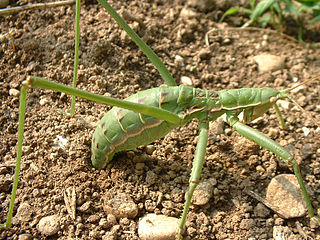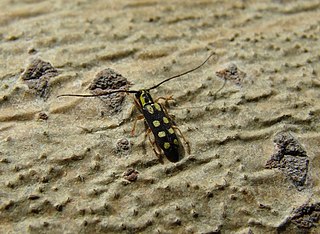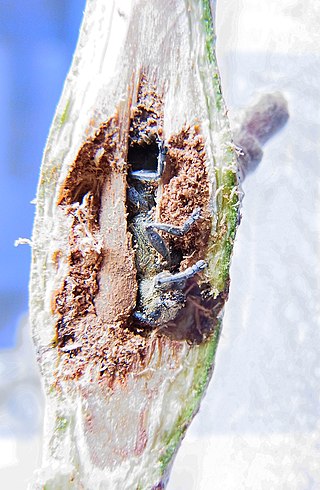Toussaint von Charpentier was a German geologist and entomologist.

Quercitrin is a glycoside formed from the flavonoid quercetin and the deoxy sugar rhamnose.

Perisomena caecigena, the autumn emperor moth, is a moth of the family Saturniidae, first described by Franz Josef Kupido in 1825. It lives in Italy and then from south-eastern Austria through Hungary, Slovenia, Croatia, Serbia, Albania, the western Ukraine, Romania, Bulgaria and Greece to most of Turkey and the Caucasus Mountains of the Republic of Georgia, Armenia and Azerbaijan. There is also an isolated population in the mountains of Lebanon and Israel. Subspecies stroehlei is endemic to the Troodos Mountains of Cyprus.

Saperda punctata is a beetle species of flat-faced longhorns belonging to the family Cerambycidae, subfamily Lamiinae.

Saperda is a genus of flat-faced longhorn beetles belonging to the family Cerambycidae, subfamily Lamiinae. The genus was erected by Johan Christian Fabricius in 1775.

Saperdini is a tribe of longhorn beetles of the subfamily Lamiinae.

The Opéra d'Avignon is an opera house located in Avignon, France that has been in operation for almost two centuries. The initial opera house was constructed in 1824–1825, and opened with its inaugural performance on 30 October 1825. The original opera house was destroyed in a fire on 26 January 1846. The current opera house was built in 1846–1847 and was designed by architects Léon Feuchère and Théodore Charpentier.

Emmanuelle Marie Charpentier is a French professor and researcher in microbiology, genetics, and biochemistry. As of 2015, she has been a director at the Max Planck Institute for Infection Biology in Berlin. In 2018, she founded an independent research institute, the Max Planck Unit for the Science of Pathogens. In 2020, Charpentier and American biochemist Jennifer Doudna of the University of California, Berkeley, were awarded the Nobel Prize in Chemistry "for the development of a method for genome editing". This was the first science Nobel Prize ever won by two women only.

Saga is a genus of bush crickets or katydids containing around 15 species as of 2018. It is the only genus in the tribe Sagini and belongs to the subfamily Saginae. Species have been recorded from southern Europe and western and central Asia.

Menesia sulphurata is a species of beetle in the family Cerambycidae. It was described by Gebler in 1825, originally under the genus Saperda. It is known from Mongolia, Kazakhstan, Japan, China, and Russia.
Saperda interrupta is a species of beetle in the family Cerambycidae. It was described by Gebler in 1825. It is known from China, Russia, Siberia, Korea and Japan. It is associated with coniferous plantations, and infests species of fir, pine, spruce and other conifers.
Saperda lateralis is a species of beetle in the family Cerambycidae. It was described by Johan Christian Fabricius in 1775. It is known from Canada and the United States.

Saperda perforata is a species of beetle in the family Cerambycidae. It was described by Pallas in 1773, originally under the genus Cerambyx. It has a wide distribution in Europe. It feeds on Populus nigra, Populus alba, and Populus tremula. It is preyed upon by the parasitoid wasp Xorides indicatorius.

Saperda populnea, the small poplar borer, is a species of beetle in the family Cerambycidae which forms woody galls on twigs of poplars and willows. It was described by Carl Linnaeus in 1758.

Bradyporus is a genus of bush crickets, found in south-eastern Europe and western and central Asia. It is the type genus of the subfamily Bradyporinae and tribe Bradyporini.

Epitheca bimaculata, the Eurasian baskettail or two-spotted dragonfly, is a species of dragonfly. It was described by Toussaint de Charpentier in 1825 and initially placed in the genus Libellula. It is the type species of the genus Epitheca.

Tessellana tessellata known as the brown-spotted bush-cricket is a European and North African insect in the tribe Platycleidini (Tettigoniidae).

Cyrtaspis is a genus of bush crickets belonging to the tribe Meconematini within the subfamily Meconematinae. They are found in mainland Western Europe and North Africa.

Paracinema tricolor is a species of band-winged grasshopper in the family Acrididae. It is found in Africa, Europe, and the Middle East.















